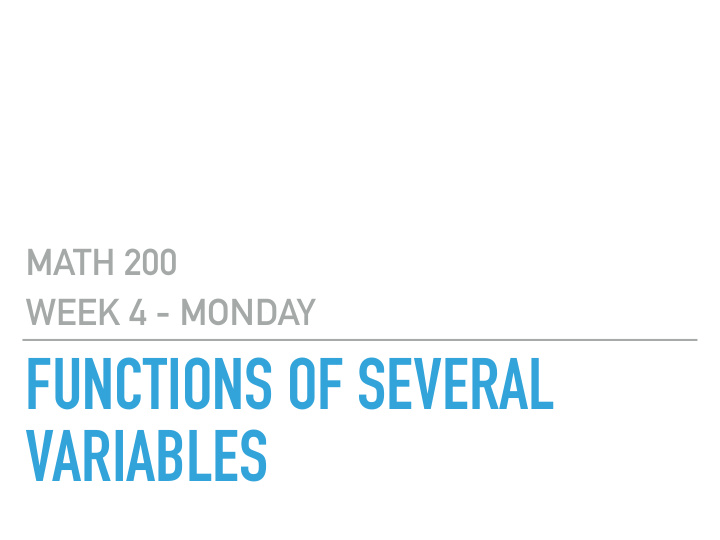



MATH 200 WEEK 4 - MONDAY FUNCTIONS OF SEVERAL VARIABLES
MATH 200 MAIN GOALS FOR TODAY ▸ Be able to describe and sketch the domain of a function of two or more variables ▸ Domains will be 2D or 3D regions ▸ Know how to evaluate a function of two or more variables ▸ Be able to compute and sketch level curves & surfaces ▸ These are just traces of the form z = k
MATH 200 EXAMPLES AND NOTATION ▸ The following are all functions of several variables ▸ f(x,y) = sin(x) + cos(y) ▸ g(x,y,z) = xyz ▸ z = ln(x 2 +y 2 ) ▸ A = bh/2 ▸ V = lwh
MATH 200 DEFINITIONS ▸ A function of two variables , x and y, is a rule that assigns to each ordered pair, (x,y), exactly one real number . ▸ We assign the value of f(x,y) to z to get a surface ▸ The domain of a function of two variables is the set of ordered pairs (x,y) for which f is defined ▸ A function of three variables , x, y, and z, is a rule that assigns to each ordered triple, (x,y,z), exactly one real number . ▸ The domain of a function of three variables is the set of ordered triples (x,y,z) for which f is defined
MATH 200 DOMAIN FOR A FUNCTION OF TWO VARIABLES ▸ Consider the function f(x,y) = ln(1-x 2 -y 2 ) ▸ We know that the input for ln() must be positive ▸ 1 - x 2 - y 2 > 0 ▸ x 2 + y 2 < 1 ▸ Let’s sketch the domain along with the graph of f
MATH 200 ONE MORE 2-VARIABLE EXAMPLE ▸ Find and sketch the domain for the function x 2 + y 2 − 1 � f ( x, y ) = ▸ We need the argument of the square root to be greater than or equal to zero ▸ x 2 + y 2 - 1 ≥ 0 ▸ x 2 + y 2 ≥ 1 ▸ All points on and outside the unit circle
MATH 200 GRAPH DOMAIN
MATH 200 DOMAIN OF A FUNCTION OF THREE VARIABLES ▸ Consider the function f(x,y,z) = arcsin(x 2 +y 2 +z 2 ) ▸ Notice that there’s no graph of f - it would be 4D! ▸ But we can still find the domain: ▸ -1 ≤ x 2 +y 2 +z 2 ≤ 1 ▸ x 2 +y 2 +z 2 ≤ 1 ▸ Every point on and inside the unit sphere
MATH 200 LEVEL CURVES AND CONTOUR PLOTS (OR CONTOUR MAPS) ▸ z=0: 0 = x 2 - y 2 ▸ A level curve for a function f(x,y) is a trace of the form ▸ x 2 = y 2 z=constant ▸ |x| = |y| ▸ It’s often useful to graph and label several level curves ▸ z=1: 1 = x 2 - y 2 together on one set of axes ▸ x 2 = y 2 + 1 ▸ We call this a contour plot ▸ z=2: x 2 = y 2 + 2 ▸ E.g. consider the function ▸ z=-1: y 2 = x 2 + 1 z=x 2 -y 2 ▸ z=-2: y 2 = x 2 + 2
MATH 200 ▸ z=0: |x| = |y| z=-1 ▸ z=1: x 2 = y 2 + 1 z=3 z=1 z=1 z=3 z=0 ▸ z=2: x 2 = y 2 + 2 z=2 z=2 ▸ z=-1: y 2 = x 2 + 1 z=-1 ▸ z=-2: y 2 = x 2 + 2 THINK OF THIS AS A TOPOGRAPHICAL MAP OF THE SURFACE f(x,y) = z
MATH 200
MATH 200 z=-1 z=3 z=3 z=2 z=0 z=2 z=1 z=1 z=-1
MATH 200 LEVEL SURFACES ▸ k = -1 ▸ While we can’t graph functions of three variables, ▸ -1 = x 2 + y 2 - z 2 we can plot their level ▸ z 2 = x 2 + y 2 +1 surfaces ▸ Hyperboloid of 2 sheets ▸ Level surfaces: given ▸ k = 0 f(x,y,z), setting the function ▸ = x 2 + y 2 - z 2 equal to a constant yields a ▸ z 2 = x 2 + y 2 level surface ▸ Double Cone ▸ E.g. consider the function ▸ k = 1 f(x,y,z) = x 2 + y 2 - z 2 ▸ 1 = x 2 + y 2 - z 2 ▸ z 2 = x 2 + y 2 -1 ▸ Set f(x,y,z) = k (const.) ▸ Hyperboloid of 1 sheet
MATH 200 ▸ k = -1 ▸ -1 = x 2 + y 2 - z 2 ▸ z 2 = x 2 + y 2 +1 ▸ Hyperboloid of 2 sheets ▸ k = 0 ▸ = x 2 + y 2 - z 2 ▸ z 2 = x 2 + y 2 ▸ Double Cone ▸ k = 1 ▸ 1 = x 2 + y 2 - z 2 ▸ z 2 = x 2 + y 2 -1 WE CAN THINK OF THESE LEVEL ▸ Hyperboloid of 1 sheet SURFACES AS 3D CROSS- SECTIONS OF A 4D OBJECT
Recommend
More recommend